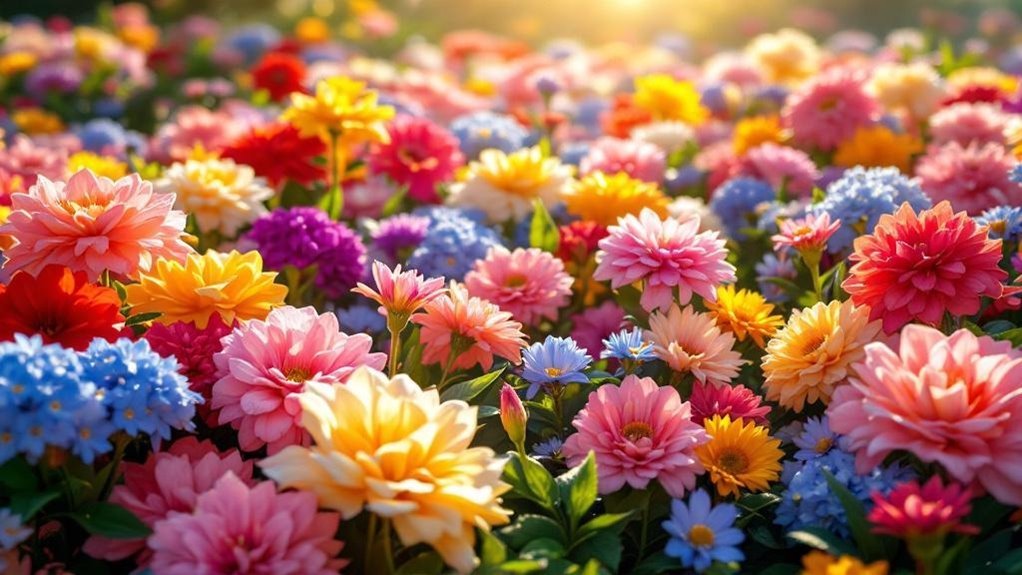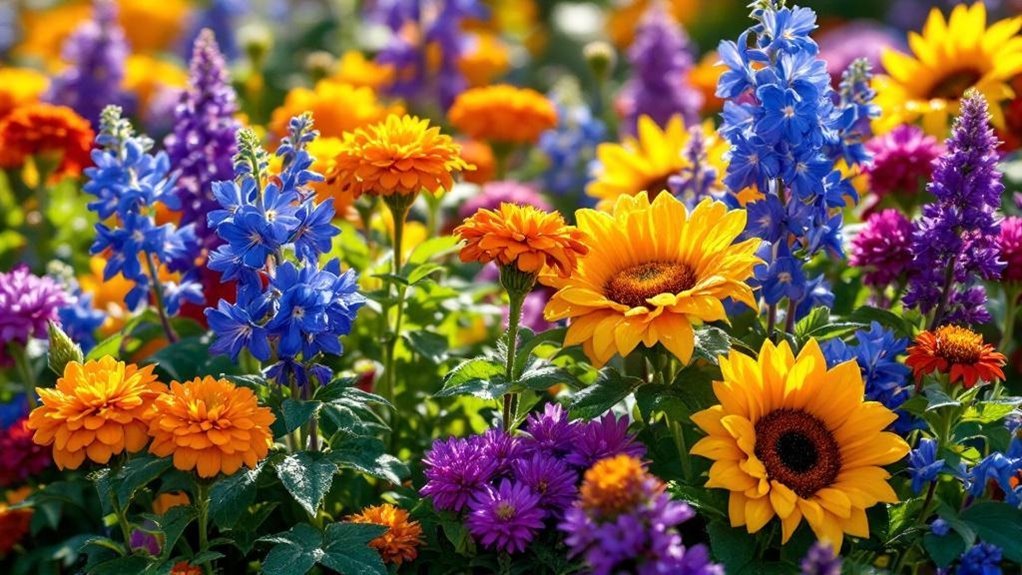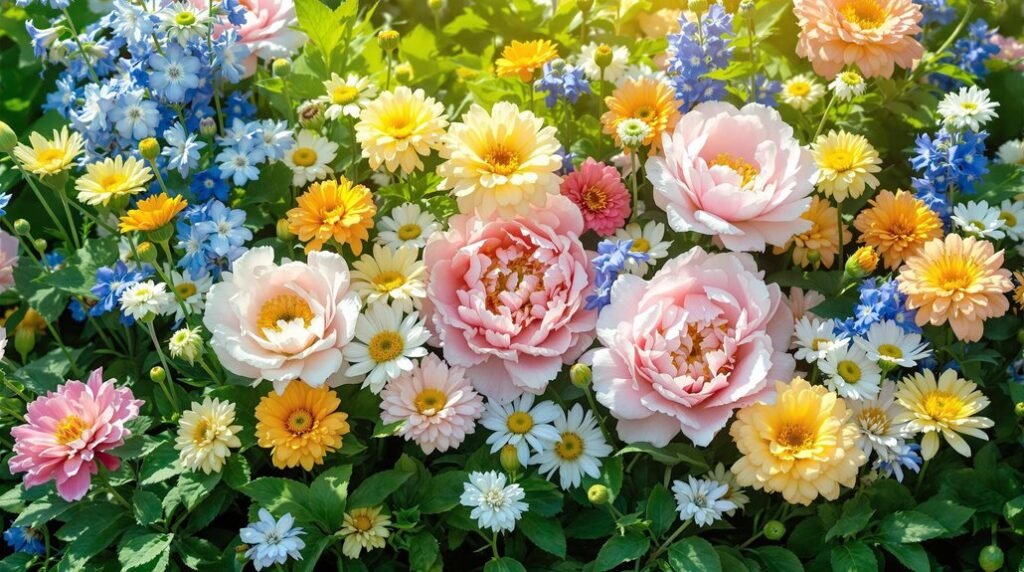Imagine your garden as a blank canvas, waiting for the perfect blend of colors to bring it to life. Choosing the right flower color scheme isn’t just about picking favorites; it’s about understanding how shades interact, complement, and contrast to create a balanced and inviting space. Before you start planting, consider how strategic color planning can transform your outdoor area into something truly memorable. There’s more to discover about crafting these visual stories.
Shades of Beautiful Guides
When you use the Shades of Beautiful Guides, you gain access to carefully curated color palettes from 2021 to 2024 that help you select the perfect hues for your garden.
Access curated color palettes from 2021 to 2024 to find the perfect garden hues.
These guides make exploring garden color schemes straightforward, whether you prefer a monochromatic color scheme for subtle elegance or vibrant complementary colors that create striking contrasts.
You can also experiment with analogous colors for harmonious blends that feel natural and soothing. By understanding these color combinations, you’ll craft flower arrangements that evoke specific moods and aesthetics.
The Shades of Beautiful Guides provide fresh inspiration rooted in current trends, making it easier for you to design a garden that’s visually stunning and cohesive.
Whether you’re new or experienced, these resources sharpen your color choices and enhance your garden’s overall appeal.
Mastering Color in Your Garden
Building on the inspiration from the Shades of Beautiful Guides, mastering color in your garden involves understanding how colors interact to create visual appeal.
Using the color wheel helps you identify complementary colors that bring vibrant contrasts and analogous colors for harmony. When choosing plants, consider mixing hues like blue flowers with orange marigolds to make focal points pop.
Here’s how to master color in your garden:
- Use primary colors as vibrant anchors to catch the eye.
- Pair complementary colors to energize your space.
- Choose plants with varied bloom times to maintain consistent color throughout seasons.
- Trust your personal taste while applying color theory for a unique, balanced look.
Exploring Different Garden Color Schemes

Although choosing colors might seem intimidating, exploring different garden color schemes can transform your outdoor space into a vibrant or tranquil retreat.
You can use complementary colors—those opposite each other on the color wheel—to create bright, energetic flower garden displays that grab attention.
Alternatively, an analogous color scheme, which combines three neighboring colors, offers a harmonious and unified look that simplifies plant selection and soothes the eye.
Mixing these schemes lets you play with contrast and cohesion, balancing boldness and calm.
By understanding how color interacts, you can craft dynamic yet balanced flower gardens tailored to your style.
Don’t hesitate to experiment; your garden’s color scheme sets the mood, making it a personal expression of creativity and beauty.
Monochromatic Garden Schemes
If you want a garden that feels cohesive and calming, a monochromatic color scheme can achieve that by focusing on variations of a single hue.
A monochromatic garden creates a unified appearance by playing with tints and shades of your chosen color, adding depth and texture without overwhelming the senses. Whether you select cool blues or warm purples, the subtle shifts in colors engage the eye and evoke serenity.
Here’s why you’ll love a monochromatic garden:
- It simplifies plant selection by focusing on compatible shades.
- It adds richness through variations in tints and shades.
- It creates a soothing, unified appearance in any space.
- It works beautifully in small gardens or containers, highlighting subtle color differences.
Embrace this approach for effortless elegance.
Complementary Color Schemes

Two colors sitting opposite each other on the color wheel can transform your garden into a vibrant and energetic space.
Using a complementary color scheme, like orange and yellow paired with bright yellow accents, creates striking contrast that grabs attention. To keep your garden dynamic, vary the hues and shades within these complementary colors instead of sticking to one flat tone.
Incorporate white flowers or lush green foliage to balance bold colors and prevent visual overload. These gardening tips help you craft focal points that evoke excitement, perfect for entrances or feature beds.
Analogous Color Schemes
Analogous color schemes draw from three neighboring hues on the color wheel, like blue, blue-purple, and purple, to create a seamless and soothing garden palette. When you work with these schemes, you’ll create a vibrant atmosphere that feels both calming and cohesive.
By combining colors thoughtfully, including warm colors like yellow, yellow-orange, and orange, you can craft inviting spaces that flow naturally. Don’t forget to vary the intensity of your chosen tones and consider foliage colors to add depth and interest.
Here’s why you should try analogous color schemes:
- They simplify plant selection, avoiding clashing colors.
- They create harmonious connections between blooms.
- They evoke warmth and comfort with warm colors.
- They let you play with light and dark shades effectively.
Bringing Your Garden Color Scheme to Life
Bringing your garden color scheme to life starts with selecting plants that not only harmonize in color but also bloom at different times to keep your space vibrant throughout the season.
Focus on your main color and complement it with various shades of red or other hues from your chosen color palette. Using color effectively means layering plants of different heights and forms to add depth and interest.
Incorporate hardscape elements like pathways or walls that echo your color palette to provide structure and enhance cohesion.
Regular maintenance, including pruning and replanting, guarantees your garden stays aligned with your design goals.
Keep evaluating the relationships within your garden’s colors and adjust as needed to maintain balance and harmony throughout the year.
Step 1: Selecting Plants for Your Color Scheme
Choosing the right plants is the foundation of your garden’s color scheme.
Selecting the perfect plants sets the stage for a beautiful and harmonious garden color palette.
To create a vibrant, harmonious space, focus on plants that complement one another and reflect your personal preference. Here’s how to start:
- Use the color wheel to pick complementary colors that enhance your garden’s appeal.
- Select plants with staggered bloom times to keep your color scheme lively throughout the seasons.
- Mix various textures and shapes to add depth and prevent a dull, flat look.
- Consider each plant’s size and growth habit for a balanced, cohesive arrangement.
Step 2: Making Use of Hardscape Elements
Hardscape elements play a crucial role in shaping your garden’s color scheme by adding structure and contrast. Using materials like natural stone, brick, or gravel complements your color palette and introduces visual interest that enhances flowering plants.
Neutral colors in hardscape elements, such as grey or beige, serve as a subtle backdrop, allowing vibrant blooms to pop. You can further unify your design by painting or staining raised beds and decorative planters to match your chosen colors.
Seasonal updates to hardscape, like swapping plant containers or adding decor, help maintain a cohesive color theme throughout the year. By thoughtfully incorporating hardscape elements, you create a balanced and engaging garden where colors stand out beautifully against structured, complementary backgrounds.
Frequently Asked Questions
How to Arrange Flower Colors in a Garden?
You can arrange flower colors by mixing complementary hues for contrast, using neighboring tones for harmony, or sticking to one color’s shades for calmness. Add neutrals to balance and consider bloom times to keep your garden lively all year.
What Colors Go Together in a Flower Arrangement?
You can pair complementary colors like blue and orange for contrast, or choose analogous shades like blue and purple for harmony. Monochromatic schemes offer unity, while triadic combinations bring balance. Neutrals tone down bright blooms beautifully.
How to Choose a Color Scheme for Your Garden?
Think of your garden as a blank canvas. Start by spotting colors around you, then mix hues from the color wheel, considering moods and bloom times. Trust your gut—choose what makes your heart bloom.
How to Plan a Flower Garden Layout?
You start by evaluating sunlight, soil, and climate. Then, arrange plants by height and texture, placing taller ones at the back. Incorporate pathways and borders for structure, ensuring blooms offer continuous color throughout the season.
Final Thoughts
Now that you’ve got the know-how to master your garden’s color scheme, it’s time to roll up your sleeves and bring your vision to life. Whether you’re channeling the elegance of monochromatic blooms or the boldness of complementary colors, your garden will soon be a masterpiece worthy of a Renaissance painting. Remember, with thoughtful plant choices and creative hardscape touches, your outdoor space will bloom with personality and timeless charm. Get planting!
